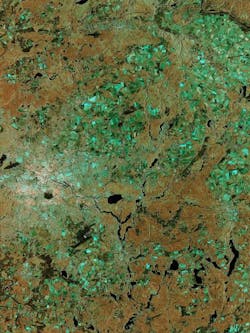European SpaceDataHighway Achieves Near-Real-Time Communications
Another milestone has been met in the development of the European SpaceDataHighway (EDRS), a high-performance alternative for space data transfer. The system of two geostationary satellites relays information between Low Earth Orbit (LEO) satellites, spacecraft, or UAVs, and fixed ground stations. Recently, a high-volume data connection at a distance of 36,000 km between a LEO satellite and a satellite located in geostationary orbit was realized.
Sentinel-1A, an Earth observation satellite, and Alphasat, a European communication satellite, were used as part of the demonstration. Each was equipped with a laser communication terminal (LCT) containing several optical components and systems. The terminals, developed by Tesat-Spacecom GmbH & Co. KG and Berliner Glas Group, allow high-speed data transfers up to 1.8 Gbits/s between LEO and geostationary orbit.
During a previous demonstration, the EDRS successfully completed a gigabit transmission via laser of imagery between the radar sensors. The image of the city of Berlin was achieved when the data transfer reached 0.6 Gbits/s of the possible 1.8 Gbits/s over 45,000km between the LCTs. With such high bandwidths, the team saw significant improvement in data latency and system reactivity.
The EDRS enables satellites to immediately transfer data to the ground, instead of the usual waiting for hours to fly over a fixed ground station—essentially in real-time. The use of optical components allows for increased amounts of data to be made available more quickly. The service EDRS provides can also be scaled and adapted for users in terms of volume transmission and security requirements. Potential applications include emergency response, open ocean surveillance, weather forecasting, and wide-area monitoring.
About the Author
Iliza Sokol
Associate Digital Editor
Iliza joined the Penton Media group in 2013 after graduating from the Fashion Institute of Technology with a BS in Advertising and Marketing Communications. Prior to joining the staff, she worked at NYLON Magazine and a ghostwriting firm based in New York.

